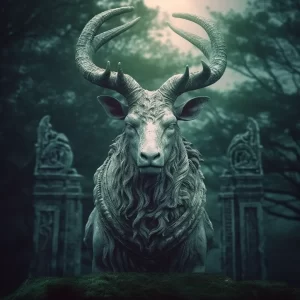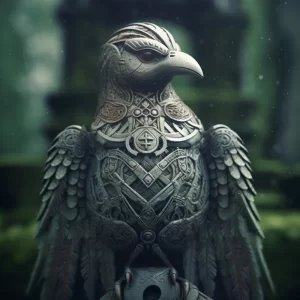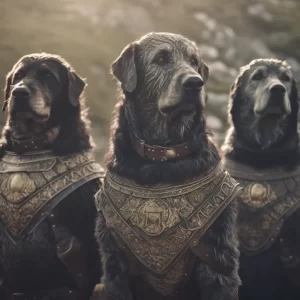Celtic Animal Mythology: Ancient Beliefs and Legends
Celtic animal mythology is a rich and complex system of beliefs that has been passed down through generations of Celtic people. Animals played a significant role in Celtic culture and mythology, serving as symbols of power, wisdom, and spiritual guidance. This section will provide an overview of Celtic animal mythology, discussing its origins, the significance of animals in Celtic culture, and some of the most important mythological creatures.
Origins of Celtic Animal Mythology
The beginnings of Celtic animal mythology can be tracked back to the time of the ancient Celts, who resided in Europe approximately from 500 BC to 400 AD. The Celts were a highly spiritual people who believed in the interconnectedness of all things, including animals. They saw animals as powerful symbols of the natural world and believed that they possessed unique spiritual qualities that could be harnessed for human benefit.
Significance of Animals in Celtic Culture
Animals held a central place in Celtic culture, serving as symbols of strength, wisdom, and spiritual guidance. Many Celtic tribes had animal totems, which were believed to represent the tribe’s unique qualities and characteristics. These totems were often depicted in artwork and jewelry, and were used in religious ceremonies and rituals.
In addition to their symbolic importance, animals were also used for practical purposes in Celtic culture. They were hunted for food, and their hides and bones were used to make clothing, tools, and weapons. Some animals, such as horses, were also used for transportation and warfare.
Celtic Mythological Creatures
Celtic mythology is filled with a wide variety of mythological creatures, many of which are animals or animal-like in nature. Some of the most important mythological creatures include:
- The Morrigan: a shape-shifting goddess associated with war, fate, and death.
- Cernunnos: a horned god of fertility, animals, and the underworld.
- The Banshee: a female spirit who wails to warn of impending death.
- The Selkie: a seal-like creature that can transform into a human and features in Celtic animal mythology.
- The Kelpie: a water spirit that takes the form of a horse and lures people to their deaths.
These creatures, along with many others, played an important role in Celtic animal mythology and were often used to explain natural phenomena or to teach important moral lessons.

Celtic Animal Gods and Goddesses
Celtic mythology is rich with animal symbolism, with many gods and goddesses taking the form of animals or being associated with specific creatures. In this section, we will explore some of the most prominent animal gods and goddesses in Celtic animal mythology.
Cat and Cu
In Irish and Celtic animal mythology, the cat was associated with the goddess Macha, who was said to have turned herself into a cat to defeat the king’s horses in a race. The cat was also associated with the warrior Cu Chulainn, who was said to have transformed into a cat-like creature during battle.
Bo and Bran
The bull, or bo, was a symbol of strength and fertility in Celtic animal mythology. In Irish mythology, the god Lugh was said to have owned a magical bull called Donn Cuailnge. The Welsh god Bran the Blessed was also associated with bulls, and was said to have owned a herd of magical cattle.
Eagle and Eel
The eagle was a symbol of power and freedom in Celtic animal mythology. The Irish god Lugus was often depicted with eagle wings, and was said to have transformed into an eagle during battle and is an important part of Celtic bird mythology. The eel, on the other hand, was associated with the goddess Boann, who was said to have created the River Boyne by disturbing the waters of a magical well with her eel-like movements.

Horse and Hound
The horse was a symbol of speed and grace in Celtic mythology. The Irish goddess Epona was associated with horses, and was often depicted riding a white horse. The hound, on the other hand, was associated with the god Cernunnos, who was said to have owned a pack of magical hounds.
Stag and Wolf
The stag was a symbol of masculinity and virility in Celtic mythology. The Irish god Cernunnos was often depicted with antlers, and was said to have transformed into a stag during the winter months. The wolf was associated with the goddess Morrigan, who was said to have transformed into a wolf during battle.
Other Celtic Animal Gods and Goddesses
In addition to the animals mentioned above, there were many other animal gods and goddesses in Celtic mythology. These included the salmon, which was associated with the wisdom of the Otherworld and Cu Chulainn, and the boar, which was associated with the warrior goddesses of the Tuatha De Danann.
The animal gods and goddesses of Celtic mythology were an important part of the culture and beliefs of the ancient Celts. They represented different aspects of nature and the human experience, and were often used as symbols of strength, power, and wisdom.
Celtic Animal Mythology: Symbolism and Magic
Celtic mythology is rich with animal symbolism and magic, with various creatures representing different aspects of nature, myths, and spirituality.
Celtic Animal Art and Appearance
Celtic animal art is known for its intricate knotwork and stylized depictions of creatures such as the owl, hare, bee, bat, black snake, and green river. These animals were often depicted in a way that emphasized their graceful and powerful nature, with bold lines and vibrant colors. Celtic art often used animals as a way to represent transitions, such as the hare symbolizing the transition from winter to spring.
Supernatural and Sacred Animals
Many animals in Celtic mythology were believed to have supernatural or sacred qualities. The crow, for example, was seen as a guide and protector, while the bird was associated with the tree of life and the light. The bear was revered as a symbol of fearlessness and courage, while the owl was seen as a creature of transition and wisdom.
Celtic Animal Magic and Spirituality
Celtic animal magic and spirituality often involved invoking the power and energy of certain creatures to help with various aspects of life. The bee, for example, was believed to bring luck and prosperity, while the bat was associated with rebirth and renewal. The river was seen as a source of grace and healing, while the snake was believed to have transformative powers.
Celtic animal symbolism and magic offer a fascinating glimpse into the rich mythology and spirituality of this ancient culture. Whether as sacred or supernatural creatures, or as sources of magic and inspiration, animals played an important role in Celtic beliefs and traditions.
Celtic Animal Mythology in History and Literature
Celtic animal mythology is a fascinating aspect of Celtic culture, history, and mythology. Animals played an important role in Celtic mythology, and many of these myths and legends have survived to this day.
Celtic Animal Mythology in Ireland
In Irish mythology, animals were often seen as sacred creatures with mystical powers. The Tuatha Dé Danann, a group of supernatural beings in Irish mythology, were said to have the ability to shapeshift into animals. The Cailleach, a goddess associated with winter, was said to have the power to turn into a wolf or a deer. The Banshee, a female spirit in Irish mythology, was said to take the form of a crow or a raven.
Many other creatures from Irish mythology are also closely associated with animals. The leprechaun, a mischievous fairy, is often depicted with a pot of gold and a love of animals. The Merrow, a sea creature in Irish mythology, is said to have the tail of a fish and the upper body of a human. The Fear Gorta, a ghostly figure associated with hunger and famine, is often depicted as a skeletal figure with a horse’s head.
Celtic Animal Mythology in Scotland and Wales
In Scotland and Wales, animals also played an important role in Celtic mythology. The Sluagh, a group of restless spirits, were said to take the form of birds and animals. The Badb, a goddess associated with war and death, was said to take the form of a crow or a raven.
Celtic Animal Mythology in Christianity
With the arrival of Christianity in the Celtic lands, many of the old myths and legends were incorporated into Christian traditions. Many of the saints in the Celtic Christian tradition were associated with animals. St. Brigid, for example, was said to have a miraculous cow that provided an endless supply of milk.
Animals played a significant role in Celtic mythology, literature, and culture. They were seen as sacred creatures with mystical powers, and many of the myths and legends surrounding them have survived to this day.

Frequently Asked Questions
What are some common Celtic animal mythology symbols?
Celtic mythology is rich with animal symbolism, and many animals were seen as sacred. In Celtic mythology, some of the most frequently occurring animal representations are the stag, the boar, the horse, the salmon, the raven, and the wolf. Each of these animals held a special place in Celtic culture and was often associated with specific deities or qualities.
What is the significance of animal totems in Celtic animal mythology?
In Celtic mythology, animal totems were seen as a way to connect with the spiritual world. Each animal totem was believed to hold a different kind of energy or power, and by aligning oneself with that energy, one could harness the animal’s strength and wisdom. Animal totems were also seen as a way to connect with one’s ancestors and the natural world.
What animals are associated with the Celtic zodiac?
The Celtic zodiac is based on a 13-month lunar calendar, with each month being associated with a different tree. Each tree is then associated with a specific animal, which is said to represent the qualities and characteristics of those born under that tree. Some of the animals associated with the Celtic zodiac include the stag, the boar, the salmon, the owl, and the wolf.
What is the role of animals in Celtic animism?
In Celtic animism, animals were seen as spiritual beings with their own unique qualities and energies. They were believed to be messengers from the Otherworld, and their presence was seen as a sign of divine intervention. Animals were also seen as protectors and guides, and many Celtic tribes had animal totems that they believed would watch over them and bring them good luck.
Who are some important spirits in Celtic animal mythology?
There are many important animal spirits in Celtic mythology, each with their own unique qualities and associations. Some of the most well-known animal spirits include the Morrigan, a goddess of war and death who is often associated with the raven; Cernunnos, a god of fertility and the hunt who is often associated with the stag; and Epona, a goddess of horses who is often associated with the horse.
What is the symbolism behind the Celtic stag?
The stag is one of the most important animal symbols in Celtic mythology, and it is often associated with strength, virility, and the hunt. In Celtic culture, the stag was seen as a symbol of the Otherworld, and it was believed that by hunting the stag, one could enter into a mystical realm of spiritual power and knowledge. The stag was also associated with the god Cernunnos, who was seen as a protector of the natural world and a symbol of fertility and abundance.

